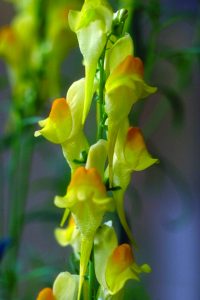
This week’s weed is very beautiful in bloom, but very noxious. If you are unfamiliar with this invasive plant, it is best seen on the south slope of Cowcatcher Ridge, up Slaughterhouse Canyon in Bellevue. The Blaine County Weed Department and Bug Crew are working hard to keep control of this noxious weed. To help us identify new infestations, it is helpful to know what this plant looks like.
Dalmatian toadflax is a perennial that grows up to 4 feet tall. It has waxy green leaves that are heart shaped and clasp the stem. The flowers are yellow, are often tinged with orange or red, and are similar in shape to a snapdragon. They flower from midsummer to fall. Seeds are produced in a pod and are irregularly wing angled. A single plant may produce up to 500,000 seeds in a season, which may remain viable in the soil for up to 10 years. This plant also reproduces vegetatively by stems that develop from adventitious buds on primary and creeping lateral roots. It’s usually associated with sparsely vegetated areas, such as roadsides, abandoned or unmanaged land, gravel pits, and disturbed pastures and rangelands. This invasive plant is reportedly toxic to livestock. Luckily, we have a bio-control agent (insect) that controls Dalmatian toadflax.
Toadflax stem-mining weevil (MEJA) are small, somewhat elongated, bluish-black weevils that emerge from last year’s infested Dalmatian toadflax stems in April-May. Adult MEJA feed on toadflax stems that are at least 0.04 inches in diameter and feed on leaves and stems from June to mid-July before mating and laying eggs inside new shoots. The eggs typically hatch in 6 to 7 days. Larvae tunnel within the toadflax stem for 23 to 34 days, moving no more than 1.2 inches from where the egg was laid. Pupation occurs within the stem. Adult MEJA feeding on stems and leaves have limited impact on the plant. L mining impacts the plants by causing premature wilting of shoots and suppressing flower formation. MEJA overwinter as adults inside their pupation chamber. The effects of the weevil on the plant are reportedly enhanced under drought stress.
If you see an infestation of this plant, please contact Colleen Clark at (208) 788-5574.
